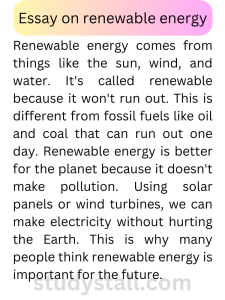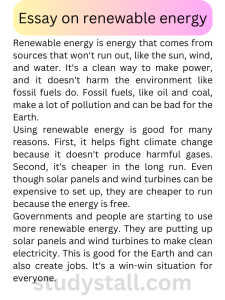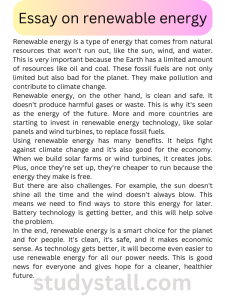Renewable energy is a pivotal topic in today’s world, where the need for sustainable and environmentally friendly solutions is more evident than ever before. As we face the challenges of climate change, depleting fossil fuel reserves, and increasing energy demands, it becomes crucial to harness and maximize the potential of renewable energy sources. In this essay, we will explore the various aspects of renewable energy, including its benefits, types, challenges, and potential for the future.
Essay on Renewable Energy (100 Words)
Renewable energy comes from things like the sun, wind, and water. It’s called renewable because it won’t run out. This is different from fossil fuels like oil and coal that can run out one day. Renewable energy is better for the planet because it doesn’t make pollution. Using solar panels or wind turbines, we can make electricity without hurting the Earth. This is why many people think renewable energy is important for the future.
Essay on Renewable Energy (200 Words)
Renewable energy is energy that comes from sources that won’t run out, like the sun, wind, and water. It’s a clean way to make power, and it doesn’t harm the environment like fossil fuels do. Fossil fuels, like oil and coal, make a lot of pollution and can be bad for the Earth.
Using renewable energy is good for many reasons. First, it helps fight climate change because it doesn’t produce harmful gases. Second, it’s cheaper in the long run. Even though solar panels and wind turbines can be expensive to set up, they are cheaper to run because the energy is free.
Governments and people are starting to use more renewable energy. They are putting up solar panels and wind turbines to make clean electricity. This is good for the Earth and can also create jobs. It’s a win-win situation for everyone.
Essay on Renewable Energy (300 Words)
Renewable energy is a type of energy that comes from natural resources that won’t run out, like the sun, wind, and water. This is very important because the Earth has a limited amount of resources like oil and coal. These fossil fuels are not only limited but also bad for the planet. They make pollution and contribute to climate change.
Renewable energy, on the other hand, is clean and safe. It doesn’t produce harmful gases or waste. This is why it’s seen as the energy of the future. More and more countries are starting to invest in renewable energy technology, like solar panels and wind turbines, to replace fossil fuels.
Using renewable energy has many benefits. It helps fight against climate change and it’s also good for the economy. When we build solar farms or wind turbines, it creates jobs. Plus, once they’re set up, they’re cheaper to run because the energy they make is free.
But there are also challenges. For example, the sun doesn’t shine all the time and the wind doesn’t always blow. This means we need to find ways to store this energy for later. Battery technology is getting better, and this will help solve the problem.
In the end, renewable energy is a smart choice for the planet and for people. It’s clean, it’s safe, and it makes economic sense. As technology gets better, it will become even easier to use renewable energy for all our power needs. This is good news for everyone and gives hope for a cleaner, healthier future.
Benefits of Renewable Energy
Renewable energy sources offer numerous advantages that make them a favorable alternative to traditional fossil fuels. These benefits include:
- Sustainability: Unlike fossil fuels, renewable energy sources are naturally replenished, making them sustainable in the long run. By harnessing renewable energy, we can reduce our reliance on finite resources and ensure a continuous energy supply for future generations.
- Reduced Environmental Impact: Renewable energy sources produce significantly fewer greenhouse gas emissions compared to fossil fuels. This reduction in emissions helps mitigate climate change, air pollution, and other environmental issues associated with traditional energy generation methods.
- Diverse Options: Renewable energy encompasses a wide range of sources, including solar, wind, hydroelectric, biomass, and geothermal. This diversity allows for flexibility in choosing the most appropriate energy sources based on regional availability, climate conditions, and technological advancements.
- Job Creation and Economic Growth: The transition to renewable energy creates new employment opportunities, stimulates economic growth, and reduces dependence on imported fossil fuels. Studies have shown that the renewable energy sector has the potential to generate millions of jobs globally.
Types of Renewable Energy
Renewable energy can be harnessed from various sources, each with its unique methods of extraction and utilization. The primary types of renewable energy sources include:
1. Solar Energy
Solar energy refers to the conversion of sunlight into electricity using photovoltaic (PV) cells or concentrating solar power (CSP) systems. PV cells directly convert sunlight into electricity, while CSP systems use mirrors or lenses to concentrate sunlight onto a receiver, which generates heat and drives a turbine.
2. Wind Energy
Wind energy involves harnessing the power of wind to generate electricity through wind turbines. As the wind blows, it turns the blades of the turbine, which then rotate a generator to produce electricity. Wind farms, consisting of multiple turbines, are often located in windy areas such as coastal regions or open plains.
3. Hydropower
Hydropower utilizes the energy of flowing or falling water to generate electricity. Dams are constructed to create reservoirs, and as water is released from the reservoir, it flows through turbines, which spin generators to produce electricity. Hydropower is a reliable and mature technology widely used worldwide.
4. Biomass Energy
Biomass energy refers to the use of organic materials, such as crops, wood, agricultural residues, or dedicated energy crops, to generate heat or electricity. Biomass can be burned directly or converted into biogas or biofuels for various applications.
5. Geothermal Energy
Geothermal energy utilizes heat from the Earth’s subsurface to generate electricity or provide heating and cooling. This involves drilling wells to access hot water or steam, which then powers turbines connected to generators. Geothermal power plants can operate continuously and produce reliable baseload electricity.
Challenges in Renewable Energy Adoption
While renewable energy holds immense potential, its widespread adoption faces several challenges that need to be addressed:
- Intermittency: Unlike traditional energy sources, renewable energy generation is often intermittent, depending on weather conditions and resource availability. This intermittency poses challenges for grid integration and necessitates the development of effective energy storage solutions.
- Initial Costs: The upfront costs of installing renewable energy systems can be higher compared to traditional fossil fuel infrastructure. However, as technology advances and economies of scale are achieved, the cost of renewable energy is decreasing, making it more economically viable in the long term.
- Infrastructure Requirements: Expanding renewable energy capacities requires significant infrastructure investments, such as transmission lines, storage facilities, and grid upgrades. These infrastructural challenges need to be overcome to ensure a smooth transition to renewable energy.
- Public Acceptance: The public’s acceptance and support for renewable energy projects are crucial for successful implementation. Addressing concerns related to visual impact, noise, and land use is essential to gain public trust and promote renewable energy adoption.
Future Potential of Renewable Energy
The future of renewable energy looks promising, driven by advancements in technology, decreasing costs, and growing environmental awareness. Here are a few areas where renewable energy holds significant potential:
- Energy Storage: The development of efficient and cost-effective energy storage systems is essential to overcome the intermittency of renewable energy sources. Advancements in battery technologies, such as lithium-ion batteries, are enabling the storage of excess energy for use during periods of low generation.
- Smart Grids: Integrating renewable energy into smart grids allows for better management and distribution of electricity. Smart grids can balance supply and demand, optimize energy usage, and enable the seamless integration of decentralized renewable energy sources.
- Offshore Wind Farms: Offshore wind farms have the potential to harness stronger and more consistent winds, providing a higher energy yield compared to onshore wind farms. As technology improves and costs decrease, offshore wind farms are expected to play a significant role in meeting future energy demands.
- Biofuels and Bioenergy: Advancements in biofuel production techniques and biomass conversion technologies hold promise for reducing carbon emissions in the transportation sector. The use of bioenergy, coupled with carbon capture and storage (CCS), can further contribute to decarbonizing various industries.
conclusion
renewable energy offers a sustainable and environmentally friendly solution to our ever-growing energy needs. With a wide array of sources available, the potential for renewable energy is immense. Overcoming existing challenges and embracing technological advancements will pave the way for a future powered by clean and renewable energy. By transitioning to renewable energy, we can create a greener and healthier planet for generations to come.
FAQ
Q: What are the benefits of renewable energy?
A: The benefits of renewable energy include sustainability, reduced environmental impact, diverse options, and job creation and economic growth.
Q: What are the types of renewable energy sources?
A: The primary types of renewable energy sources are solar energy and wind energy.
Q: How is solar energy generated?
A: Solar energy is generated through the conversion of sunlight into electricity using photovoltaic (PV) cells or concentrating solar power (CSP) systems.
Q: How is wind energy harnessed?
A: Wind energy is harnessed by using turbines to convert the kinetic energy of the wind into electricity.
